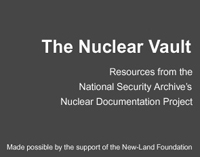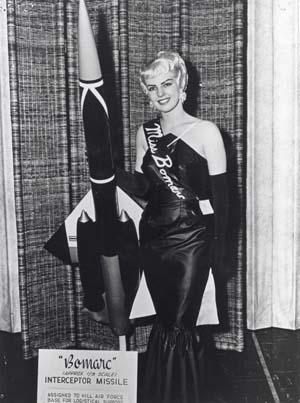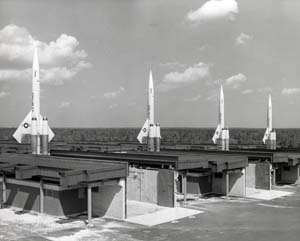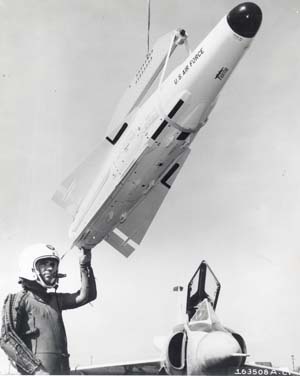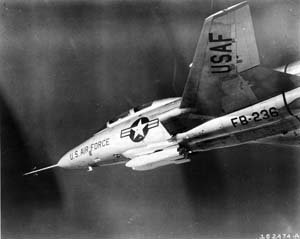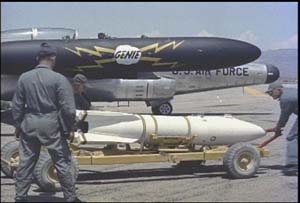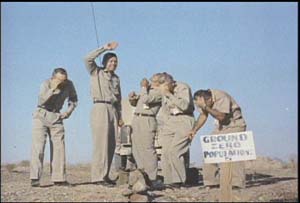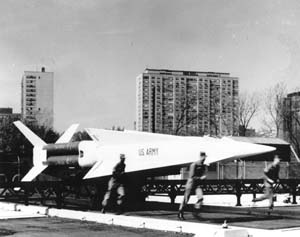home | about | documents | news | publications | FOIA | research | employment | search | donate | mailing list
Cold War Air Defense Relied on Widespread Dispersal of Nuclear Weapons, Documents Show
Deployments Had Dangerous Potential Because of Predelegation Arrangements
National Security Archive Electronic Briefing Book No. 332
Posted - November 16, 2010
For more information contact:
Christopher Bright
CBright@christopherjohnbright.com
www.ChristopherJohnBright.com
|
||
|
||
|
||
|
||
|
||
|
||
|
||
Washington, D.C., November 16, 2010 - To counter a Soviet bomber attack, U.S. war plans contemplated widespread use of thousands of air defense weapons during the middle years of the Cold War according to declassified documents posted today at the National Security Archive's Nuclear Vault and cited by a recently published book, Continental Defense in the Eisenhower Era: Nuclear Antiaircraft Arms and the Cold War (Palgrave Macmillan) by historian Christopher J. Bright. The U.S. government publicly acknowledged the facts of the deployments in the 1950s, yet they garnered surprisingly little public opposition, Bright concludes, in disclosing for the first time that air defense weapons comprised as much as one-fifth of the US nuclear arsenal in 1961. Still, nearly 25 years after the United States retired the last of them in 1986, their exact number remains secret.
During the Cuban Missile Crisis, the most perilous crisis of the Cold War, Bright shows that top Defense officials wanted to limit a response to a bomber attack to conventional weapons, not realizing how much plans and deployments rested solely on nuclear weapons. Bright's work also raises the possibility that air defense weapons may have been among the most dangerous nuclear arms because of their widespread deployment and the predelegated use arrangements that could have led to inadvertent nuclear use during a crisis.
Continental Defense in the Eisenhower Era is a reminder of the extent to which nuclear weapons were integral to Cold War American military strategy. It comes at a time when U.S. policy makers are giving renewed attention to nuclear arms, occasioned in part by President Barack Obama's support for their ultimate abolition, and the suggestion by others that existing U.S. nuclear warheads should be replaced or refurbished, along with continuing political disagreement about the necessity and adequacy of a New START arms control treaty with Russia.
Bright's book recounts many other formerly secret details about the thousands of Army and nuclear air defense weapons built during the Cold War, the plans and procedures for their use, and their eventual withdrawal. Drawing upon declassified documents held by the National Security Archive (including material in ninety boxes of files donated in 2003 upon the death of nuclear researcher Chuck Hansen) and other once-secret information originating at the White House, Pentagon, Atomic Energy Commission and elsewhere, Continental Defense in the Eisenhower Era discusses the development and deployment of:
- 3155 Genie air-to-air rockets (with two kiloton nuclear warheads) estimated to have armed scores of Air Force interceptor aircraft at 31 bases in 20 states starting in 1957
- 1900 Falcon guided air-to-air missiles (with a half kiloton warhead) which later also equipped some of these and other airplanes
- 2500 Army Nike-Hercules surface-to-air missiles (carrying two or 22 kiloton warheads) that the Army positioned at 123 launch sites around 26 cities and 10 Air Force bases in 25 states
- 409 Air Force BOMARC long range surface-to-air missiles (each with six and one-half kiloton warheads) located at eight launch sites in seven eastern and northeastern states (in addition to two locations in Canada)
Before the advent of intercontinental ballistic missiles, the fear of a surprise mass Soviet bomber attack spurred defense planners and government scientists to compensate for technological limitations of antiaircraft arms of the era. Recognizing the difficulty of targeting relatively high-flying, fast-moving airplanes, proponents of nuclear air defense believed that relatively small defensive nuclear warheads compensated for inaccuracy by producing comparatively large lethal blast zones. They further argued that nuclear warheads would assuredly destroy attacking planes and the bombs they carried, while posing minimal risk to those on the ground. Policy makers, including President Dwight Eisenhower, military service leaders, and members of Congress, agreed. Defense officials announced the deployments to the public; arms manufacturers and the news media also publicized them. There was little public dissent. Even members of the nascent anti-nuclear movement at the time devoted almost no attention to these arms. While this does not indicate their assent to the weapons, it suggests that they did not see nuclear air defense weapons as especially worrisome.
Among the related topics addressed in Continental Defense in the Eisenhower Era:
- Eisenhower authorized in advance (or "predelegated") the use of these arms in the event that an aerial attack upon the US was known to be underway but the president could not be contacted. Although intended to be secret, a senior U.S. Air Force officer, General Earle Partridge, disclosed this publicly in 1957 and 1958.
- In February 1958, an Air Force publicist revealed the cost of the Genie's W-25 nuclear charge, one of only two occasions in which the expense of a U.S. nuclear warhead has been revealed.
- The Genie rocket was test-fired from an Air Force plane over Nevada in July 1957. Five officer volunteers stood below in an attempt to demonstrate that the weapon could be utilized without endangering those on the ground.
- In July 1958, extensive preparations had been made to test-fire additional Genies as well as Nike-Hercules missiles over the Gulf of Mexico. Days before the operation was scheduled to be conducted, Eisenhower canceled the test, in an Oval Office meeting with Secretary of State John Foster Dulles and others.
- The Soviet Union was interested in the details of American nuclear antiaircraft arms. In 1958, the USSR's military intelligence agency apparently recruited an Army lieutenant colonel (one of the highest-ranking US officials suspected of having engaged in espionage on behalf of a foreign power) to provide classified information about the Nike-Hercules. This alleged activity was not uncovered until several years later when Soviet colonel Oleg Penkovskiy, an American agent, reported that the Army missile information was in the USSR's possession.
Despite the ubiquity and visibility of air defense nuclear weapons to Americans a generation ago and the importance of many of these and other related issues, Continental Defense in the Eisenhower Era marks the first book-length scholarly examination on the topic. Coinciding with the publication, the National Security Archive is posting thirteen documents which highlight many of these and other important topics covered in the book.
Continental Defense in the Eisenhower Era is based upon a dissertation written at The George Washington University under the direction of Leo P. Ribuffo, the Society of the Cincinnati George Washington Distinguished Professor of History. Further guidance was provided by GW historians James G. Hershberg and William Becker; the National Defense University's David Alan Rosenberg; and William Burr, a senior analyst and director of the nuclear history documentation project at the National Security Archive.
Further details about Continental Defense in the Eisenhower Era are available at www.ChristopherJohnBright.com.
Read the Documents
Documents 1A and B: Nuclear Air Defense and the Killian Report
Document 1A: "Meeting the Threat of Surprise Attack; Technological Capabilities Panel of the Science Advisory Committee," vol. II, February 14, 1955, pp. 75-76. Formerly classified TOP SECRET.
Source: Declassified Documents Reference System no. CK3100218088.
Document 1B: Meeting the Threat of Surprise Attack; Technological Capabilities Panel of the Science Advisory Committee," vol. II, February 14, 1955, pp. 105-108. Formerly classified TOP SECRET.
Source: Box 21, Folder 1, Chuck Hansen Collection.
In August 1954 President Eisenhower appointed Massachusetts Institute of Technology President James R. Killian, Jr. to lead a group of scientists and engineers to examine technological applications that could improve the nation's offensive forces, intelligence collection, and continental defense efforts. Between then and February 1955, forty-two outside experts on the Technological Capabilities Panel met 307 times for meetings, briefings, and field trips, aided by a small staff. In addition to Killian, the group's steering committee included Polaroid camera inventor Edwin H. Land, Williams College president James Phinney Baxter III, and retired General James H. Doolittle, the World War II hero who held an MIT aeronautical engineering doctorate.
The panelists presented the highlights of their two-volume 190-page assessment, entitled "Meeting the Threat of Surprise Attack," to the National Security Council in a four-hour meeting on March 17, 1955. The danger posed by a thermonuclear-equipped adversary and the consequent requirement for effective air defenses was a significant theme of the Killian study.(Note 1) The report recommended that nuclear warheads become "the major armament" for American air defense arms. Maintaining that attackers should be engaged by defense forces as soon as warning systems identified bombers and the latter were at a great distance from their targets, the panel also called for granting the military "advance authority for the instant use of atomic warheads." Additionally, the committee recommended that one "high altitude" nuclear shot in a forthcoming test series be promoted by officials in a way which might reduce public angst about the dangers of deploying or using nuclear antiaircraft weapons. The Killian panel believed that the relatively low yield of nuclear antiaircraft arms, and the altitude at which they would be detonated, meant that if used, they would pose little harm to those on the ground below. Even "[i]f all the air defense weapons were actually fired, the total kilotonage would approximate that of a single strategic weapon." According to the group, "the radioactivity which would be added to the atmosphere by the use of the warheads is of no consequence at all."
Document 2: Testing the Weapons
Letter from K.E. Fields to Henry M. Jackson, February 24, 1956. Formerly classified SECRET.
Source: Department of Energy/Nevada Nuclear Testing Archive accession no. NV0074039.
In January 1956, the congressional Joint Committee on Atomic Energy asked the AEC to consider testing versions of the MB-1 Genie (code-named "Ding Dong") and Nike-Hercules (termed "Nike B") once they were in production. Various iterations of the warheads had been detonated (and others scheduled to be exploded in the forthcoming Operation Redwing) and the design of the missile and rocket components had been validated. However, neither Genie nor Nike-Hercules had been operated as a complete weapon in a single exercise from launch to nuclear blast. The AEC believed its function was the design, manufacture, and testing of nuclear components, and it had little interest in funding, supporting, or organizing what it considered to be practice firings of completed arms. AEC general manager Kenneth Field attempted to convince congressional proponents that such exercises were unnecessary (arms were "capable of being stockpiled even without a true proof test," he wrote), but pledged nonetheless that the AEC "shall coordinate" with the Pentagon "as to the necessity" of a test "of a complete version of the Ding Dong and the Nike B." For the Genie, the Defense Department prevailed. On July 19, 1957 in Shot John of Operation Plumbbob, an interceptor detonated an MB-1 at 18,000 feet above five U.S. Air Force officer volunteers (and one photographer) standing on the ground at AEC's Nevada Test Site. One Air Force assessment concluded the operation showed that the "MB-1 air-to-air rocket can be successfully delivered in an operational situation..."(Note 6) The next year, a similar Nike-Hercules test and a second MB-1 firing was aborted after last minute presidential intervention. (See Documents 5A and 5B).
Document 3: Publicity for Air Defense Nukes
Letter from Herbert B. Loper to Lewis L. Strauss, December 18, 1956, in Folder "OCB 000.9 [Atomic Energy] (File #5) (6) [August 1956–January 1957]." Formerly classified SECRET.
Source: Box 11, OCB Central Files Series, White House Office, NSC Staff Papers, 1948–61, Dwight D. Eisenhower Library.
On January 1, 1957 the U.S. Air Force declared operational the MB-1 Genie rockets. The month before, Herbert Loper, an aide to Defense Secretary Charles Wilson, wrote Lewis Strauss, the Chairman of the Atomic Energy Commission, about the need for "a public announcement" of the nation's "new capability" in nuclear air defense weaponry. Loper outlined the Pentagon's approach to announcing the deployment of the Genie and the Army's Nike-Hercules, which was also scheduled to be introduced in the next year. A news release was desirable, Loper wrote, because "widespread deployment" of these weapons "in close proximity to the civil populace" makes "public knowledge and understanding" a "matter of major importance." He argued that the arms "should have a positive effect on national morale" because they "provide a more effective defense against enemy nuclear attack and can be safely deployed on a nation-wide scale."
Document 4: Weapon Costs Revealed
"Address by Colonel Barney Oldfield, Director, Information Services, North American Air Defense Command, Before the Clinton Junior Chamber of Commerce Annual ‘Bosses Night,'" Clinton, Iowa, February 19, 1958." Not Classified.
Source: Oldfield Papers, Series 6, Box 31, Folder 5, in collection of Nebraska State Historical Society.
The volunteers participated in Shot John because of the intercession of Air Force Colonel Arthur B. "Barney" Oldfield, the public information officer for the Continental Air Defense Command, who had been instructed to consider ways to trumpet the Genie's introduction. "[E]ven though high classification" meant there was "limited room for sensible discussion" and "public reassurance" about Genie, recalled Oldfield, General Earle E. Partridge "wanted the weapons ‘out in the open'."(Note 2) In an address in Clinton, Iowa in February 1958, Oldfield declared that, although the Genie's rocket vehicle was worth seven thousand dollars, once the "atomic load" was inserted, the price reached "a quarter of a million dollars." The next year, he noted the Genie's cost in a press release issued in conjunction with a Las Vegas air fair. After the announcement garnered a front-page article in the Washington Post and Times-Herald, the Air Force investigated.(Note 3) The cost of nuclear weapons was an important secret because defense officials believed that an adversary could estimate the size of the U.S. arsenal based on the total AEC budget. As a result, the Air Force "administratively reprimanded" Oldfield. Years later, he wrote, "there are times when breaking classification solves more than hardened artery adherence to it."(Note 4) Nonetheless, Oldfield's statement about the Genie cost was the first time an official acknowledged the figures for a specific American nuclear weapon. During the entire Cold War and ensuing years, the cost of only one or two other warhead types may have been officially confirmed.(Note 5)
Documents 5A and B: Controversial Testing Proposal
Document 5A: "Memorandum of Conference with the President, June 27, 1958—11:05 AM" June 30, 1958, Folder "Atomic Weapons, Correspondence and Background for Presidential Approval and Instructions for Use of [1953–1960] (2)." Formerly classified TOP SECRET. (Note 7)
Source: Folder "Atomic Weapons, Correspondence and Background for Presidential Approval and Instructions for Use of [1953–1960] (2)," Box 1, in NSC Series, Subject Subseries, White House Office, Office of Special Assistant for National Security Affairs, Records, 1952–61, Dwight D. Eisenhower Library.
Document 5B: "Memorandum of Conference with the President, July 24, 1958, following NSC," July 24, 1958. Formerly classified SECRET.(Note 8)
Source: Folder "Staff Memos July 1958 (11)," Box 35, Dwight D. Eisenhower Diary Series, Dwight D. Eisenhower Papers as President, 1953–61, Dwight D. Eisenhower Library.
The Pentagon scheduled a Nike-Hercules operational exercise and a second full-fledged Genie test to take place over the Gulf of Mexico in 1958. However, President Eisenhower halted the operation a week before it occurred following two Oval Office meetings with senior military and civilian officials. From the outset, the AEC opposed the operation. AEC Chairman Lewis Strauss "questioned the possible adverse public reaction" if the operation went ahead. (Note 9) Nonetheless, the Army prepared to have a Nike-Hercules battery at Eglin Air Force Base's Santa Rosa Island launch two missiles over the Gulf, each with different version of the W-31 nuclear charge, at a formation of three obsolete Air Force F-80 fighters converted into drones. In the same exercise, the Air Force intended to have interceptors fire Genies at other unmanned aircraft. Both the Army and Air Force were to make use of airspace "25 nautical miles horizontal distance from the nearest populated area" which had been a military training area for years and was routinely used to test Air Force weapons (albeit never nuclear arms).(Note 10) The U.S. Public Health Service also made arrangements to collect air, rainwater, milk, crop, and seafood samples in cooperation with health departments in Georgia, Florida, Alabama, and Mississippi. "In all cases we were received most cordially and promised full cooperation," a senior USPHS official reported.(Note 11)
On June 27, 1958, Lewis Strauss, Secretary of State John Foster Dulles and others discussed the Eglin operation with President Eisenhower. Strauss emphasized his belief that what he considered unnecessary tests of production nuclear arms might imperil future test activities he thought which were central to the AEC's mission. Dulles and his deputy, Christian Herter, expressed concern that neighboring nations might react poorly to the operation. Eisenhower decided that if the governments of Cuba or Mexico objected, "the matter would have to be reconsidered." A month later, as test preparations proceeded, another White House meeting was convened. Dulles reported to Eisenhower that "consultations" with Cuba and Mexico led him "to recommend strongly" that the nuclear operation be moved to the Pacific. The president then "approved transfer or cancellation" of the operation but requested "some study of some combination of activities to accomplish the same objectives." While the military moved to continue the operation in Florida with conventional rounds, Public Health Service officials contacted their state-level counterparts, informed them of the nuclear test halt, expressed appreciation for "complete cooperation," and asked them to "forget our activities in the area."(Note 12) The request was heeded. There is no evidence that the 1958 test arrangements became known at the time.
Document 6: Revelation of Predelegation
Donald A. Quarles [Deputy Secretary of Defense] memorandum for the president (with attachments), October 13, 1958. Formerly classified CONFIDENTIAL.
Source: Folder "Department of Defense, Vol. III (3) [October–December 1958]," Box 1, Subject Series, Department of Defense Subseries, White House Office, Office of Staff Secretary, Records, 1952–61, Dwight D. Eisenhower Library.
Before the advent of nuclear antiaircraft weapons, any expenditure of atomic arms required explicit presidential permission. However, the Killian committee asserted in February 1955 that the brief and hectic period following the detection of a bomber attack made it difficult if not impossible to secure the necessary authority while still allowing ample time to react. Consequently, as the National Security Archive has revealed previously, on April 18, 1956 the president executed an "Authorization for the Expenditure of Atomic Weapons in Air Defense" which allowed military officials to use nuclear air defense arms in certain emergency situations without further approval.(Note 13) This was intended to be a secret. However, when U.S. News and World Report conducted an extended interview with General Earle Partridge of the Continental Air Defense Command (CONAD) in September 1957, the magazine inquired, "[D]o you have to get the President's permission before using one of these atomic rockets?" "Yes," replied the general. "However, the President has given his approval to use, without reference to anybody, any weapon at our disposal if there is a hostile aircraft in the system." "You don't have to wire Washington?" the magazine asked in clarification. "No," Partridge replied. But he also explained, "[w]e probably would be on the phone talking to people when the thing went off."(Note 14)
This story produced little public or official reaction until New York Times reporter Jack Raymond cited the Partridge interview in an October 1958 story. Raymond caused a stir when he reported that the North American Air Defense Command was "authorized to fire a nuclear weapon in combat without the specific approval of President Eisenhower."(Note 15) Deputy Defense Secretary Donald Quarles asked for an explanation. He was told that the Pentagon had previously approved the U.S. News article and that CONAD had used it on other prior occasions as a basis for other briefings to journalists. Quarles countered that CONAD had received a broadly worded message a month before "countermanding" the prior permission to discuss the topic. Partridge responded that he disregarded this instruction because the communication was worded in a way which left it unclear if it was applicable to CONAD. Reporting this exchange to President Eisenhower, Quarles relayed Partridge's contrition, and also expressed sympathy for the general's confusion about the prevailing policy. In addition, Quarles reported to the president that the Pentagon was distributing more precise regulations to clarify the prohibition on public comment.
Document 7: Development of Small, Light-weight Nuclear Weapons
Paul Ager memorandum to Alfred D. Starbird, November 24, 1958. Formerly classified SECRET.
Source: Chuck Hansen Collection, box 28, Folder 3.
The Falcon air-to-air missile, developed by Hughes Aircraft, was designed originally to carry a conventional warhead. It was six and one-half feet long, had a small diameter, and tipped the scale at less than one hundred and fifty pounds. It was carried by the Air Force's F-102 interceptor. When the F-102 was slated to remain in service longer than intended, Air Force Vice Chief of Staff Curtis LeMay sought to field a nuclear version of the Falcon. However, the size and relatively weight of the Falcon airframe posed significant challenges for designers of the nuclear warhead destined for it, because Air Force wanted a warhead mated to the Falcon which required only modest missile modifications or performance inhibitions. When members of the Joint Committee on Atomic Energy visited the AEC's Los Alamos laboratory and the Sandia Corporation in November 1958, they heard apparently futile complaints that the precise dimensional limits imposed on the nuclear components threatened to greatly increase the warhead's development costs.
The W-54 warhead which was ultimately developed in 1959 for the Falcon was fifteen inches long, nearly eleven inches in diameter, and weighed only fifty pounds. When the Genie's 220-pound W-25 warhead was approved in 1956, it was state of the art. The fact that three years later a nuclear device could be produced that was a fraction of the W-25's size and weight demonstrates the trajectory and speed of the American nuclear weapon design effort in the period.
Document 8A and B: Accidents Happen
Document 8A: Memorandum, "Report of Special Weapons Incident [deleted], Bomarc Site, McGuire AFB, New Jersey," June 13, 1960. Formerly classified SECRET.
Source: Box 30, Folder 5, Chuck Hansen Collection.
Document 8B: "Airmunitions Letter," September 8, 1960. Formerly classified SECRET.
Source: Box 31, Folder 1, Chuck Hansen Collection.
On June 3, 1960, the BOMARC missile installation near McGuire Air Force Base in New Jersey passed an inspection that evaluated the unit's nuclear warhead handling, safety, and security procedures. Nevertheless, four days later, a highly pressurized helium used in the BOMARC fueling process burst with explosive force in one of the missile launch shelters. This sparked an enormous fire. Airmen trained hoses on the conflagration, which kept the flames from spreading beyond the affected building, but the intense heat and flame enveloped one missile. As the fire was brought under control in the following hours, a specially trained seven-person nuclear-response team arrived from a New York Air Force base. Spot checks across sixty-six square miles outside the facility's boundaries found no trace of radiation. Nonetheless, it was, according to an Air Defense Command history, "perhaps the worst" event involving any of the ADC's nuclear weapons. (Note 16)
Document 9A and B: The Cuban Missile Crisis
Document 9A: Cable from CINCNORAD, General John Gerhart to Joint Chiefs of Staff, CINCNORAD message 262345Z, October 27, 1962. Formerly classified TOP SECRET.(Note 17)
Source: Chief of Naval Operations Cuba history files, Boxes 58–72, Operational Archives, U.S. Naval Historical Center.
Document 9B: Joint Chiefs of Staff, War Room Journal, October 31, 1962. Formerly classified SECRET.
Source: National Security Archive Cuban Missile Crisis document collection, document no. CC01773, item 29.
The Eisenhower administration's air defense arrangements did not contemplate the possibility of a bomber attack from the south, but the Cuban Missile Crisis raised fears about an strike on the southeastern United States by Soviet IL-28 bombers based in Cuba. With no antiaircraft missiles deployed in Florida or the adjacent areas in 1962, on October 24, NORAD commander John Gerhart ordered a mobile Nike-Hercules battalion to move by train from Fort Bliss, Texas, to the Miami area.
In a message to the Joint Chiefs, Gerhart worried about the adequacy of the Commander-in-Chief Atlantic's (CINCLANT) "operational plan" (or "OPLAN") that would go into effect if war broke out. "Rules of engagement for the Florida area prescribe the use of high explosive weapons only," but Gerhart believed that if Soviet bombers entered U.S. air space from Cuba it was "imperative to use weapons with maximum kill capability." Reminding the JCS that NORAD already had predelegated authority to use nuclear weapons in certain instances, he asked whether the OPLAN altered this "authority . . . to use nuclear weapons . . . should a raid from Cuba penetrate the Air Defense Identification Zone or sovereign boundaries of the U.S." According to Gerhart, most Nike-Hercules missile batteries were exclusively nuclear-capable. Using the two-letter abbreviation for "high-explosive" rounds, Gerhart cabled, "your attention [is] invited to the fact that in most locations Nike-Hercules units have no[,] repeat no[,] HE warheads."
In response, the JCS reiterated air defense forces in the Florida area were to be "nonnuclear" only. They emphasized, however, that "nuclear weapons could be used to destroy hostile aircraft" if an attack was indicated by a "pattern of actions elsewhere."(Note 18) The next day, Lieutenant General Theodore W. Parker, the Army's deputy chief of staff, then posted at the JCS war room, asked subordinates to determine if it was "a fact" that the Nike-Hercules sites across the nation had few nonnuclear warheads. The situation room log shows the reply: "For the most part this is true. There are two HE warheads in each of 34 sites." Parker also confirmed that the Nike-Hercules unit being shipped to Florida also had only high-explosive warheads on all seventy-two missiles it carried. Parker's inquiries and the JCS's stipulations makes clear that the latter had prohibited the use of nuclear antiaircraft weapons around Florida during the Missile Crisis, despite longstanding policies intended to facilitate the use of such arms.
Notes
1. The Killian Commission is treated in Valerie L. Adams, Eisenhower's Fine Group of Fellows: Crafting a National Security Policy to Uphold the Great Equation (Lanham, Maryland: Lexington Books, 2006), pp. 115–116; James R. Killian, Jr., Sputnik, Scientists, and Eisenhower: A Memoir of the First Special Assistant to the President for Science and Technology (Cambridge: MIT Press, 1977), p. 68; David L. Snead, The Gaither Committee, Eisenhower, and the Cold War (Columbus: Ohio State University Press, 1999), pp. 35–40; McGeorge Bundy, Danger and Survival: Choices about the Bomb in the First Fifty Years (New York: Random House, 1988), pp. 325–328; and Gregory W. Pedlow and Donald E. Welzenbach, The CIA and the U-2 Program, 1954–1974 (Washington: Central Intelligence Agency, 1988).
2. "Memo from the Office of the Commander-in-Chief CON[tinental]A[ir]D[efense Command]," n.d., in RG3702.AM, "Oldfield, Barney [Arthur Barney]," Series 4 "Personal Papers, 1928–1970s," Box 30, Folder 10 "NORAD, 1954–1962" in collection of Nebraska State Historical Society.
3. John G. Norris, "AF reveals A-Warhead Cost Figure," Washington Post and Times-Herald, April 15, 1959, A1.
4. See Kuter memorandum to Oldfield attached to "Memo from the Office of the Commander-in-Chief, CON[inental]A[ir]D[efense Command]," and Laurence S. Kuter memorandum captioned "Subject: "Recommendation for the Legion of Merit," July 19, 1962 in Oldfield Papers, Series 4, Box 30, Folder 10.
5. For the cost of the Mk-74 and Mk-75 nuclear artillery shells, see "Restricted Data Classification Decisions, 1946 to the Present (RDD-8)," U.S. Department of Energy, January 1, 2002, p. 96. In addition, in the 1990's the cost of the Advanced Cruise Missile's W-80 warhead was inadvertently disclosed. See Kevin O'Neill, "Building the Bomb," in Steven I. Schwartz, ed., Atomic Audit: The Costs and Consequences of U.S. Nuclear Weapons Since 1940 (Washington: Brookings Institution, 1998), p. 94.
6. "Operation Plumbbob; Nuclear Radiation Received by Crews Firing the MB-1 Rocket, Project 2.9," May 27, 1959, p. 14, Box 25, Folder 1, Chuck Hansen Collection.
7. This memorandum was fully declassified in 2001 at the request of the National Security Archive, in part, because the balance of the meeting it addresses covers predelegation instructions for other types of nuclear weapons. The reference to nuclear tests over the Gulf of Mexico generated some press coverage when the document was released. (See "Eisenhower Authorized Use of Nuclear Weapons over Mexico," Agence France Presse, May 19, 2001.)
8. This memorandum was declassified decades ago. However, at least two scholars have misunderstood its significance since then, probably because other information was not available to place it in the proper context of antiaircraft weapons. Robert Divine suggested the subject was "an astonishing Pentagon proposal—to conduct tests of the experimental anti-missile missile, complete with an atomic warhead, over the Gulf of Mexico." (See Robert A. Divine, Blowing in the Wind: The Nuclear Test Ban Debate, 1954–1960 (New York: Oxford University Press, 1978), p. 220.) Similarly, Stephen Ambrose characterized the discussions as related to "the ABM." (See Stephen E. Ambrose, Eisenhower: The President (New York: Simon and Schuster, 1984), p. 477.)
9. Minutes of AEC-MLC conference attached to W.B. McCool memorandum for the Atomic Energy Commission, July 23, 1958; and SWPWT telex to CDR APOG [et al.], May 20, 1958, Box 26, Folder 3, Hansen Collection.
10. [Alfred D.] Starbird telex to [K.F.] Hertford, et al., May 2, 1958, Department of Energy/Nevada Nuclear Testing Archive accession no. NV0123110; Minutes of AEC-MLC conference attached to W.B. McCool memorandum for the Atomic Energy Commission, July 23, 1958, Department of Energy/Nevada Nuclear Testing Archive accession no. NV0072600.
11. John R. McBride memorandum to Assistant Chief, and Acting Chief, Division of Radiological Health, July 25, 1958, Department of Energy/Nevada Nuclear Testing Archive accession no. NV0023334; Melvin W. Carter memorandum to James G. Terrill, Jr., August 6, 1958, Department of Energy/Nevada Nuclear Testing Archive accession no. NV0023332 (quotations).
12. Melvin W. Carter memorandum to James G. Terrill, Jr., August 6, 1958.
13. "Memorandum for the Executive Secretary, National Security Council," from John Foster Dulles, April 17, 1956, in Folder "Policy Regarding Use of Nuclear Weapons," Box 11, Record Group 59, DoS Records, Executive Secretariat, NSC Meeting Files and Reports, National Archives and Records Administration.
14. "$61 Billions [sic] for a 2-Hour Warning Against Sneak Attack," U.S. News and World Report, September 6, 1957, pp. 72–85.
15. Jack Raymond, "Air Defense Unit Has No Atom Curb," New York Times, October 7, 1958, p. 11.
16. Thomas W. Ray, BOMARC and Nuclear Armament, A[ir] D[efense] C[ommand] Historical Study No. 21 (n.p.: Air Defense Command, n.d.), p. 35.
17.This document was found in U.S. Navy archives by journalist Michael Dobbs when researching his important book One Minute to Midnight : Kennedy, Khrushchev, and Castro on the Brink of Nuclear War (New York: Alfred A. Knopf, 2008).
18. Memorandum for General Parker, Admiral Sharp, General Burchinal, General Hayes, December 21, 1962, National Security Archive Cuban Missile Crisis document collection, document no. CC02780, p. 50.
